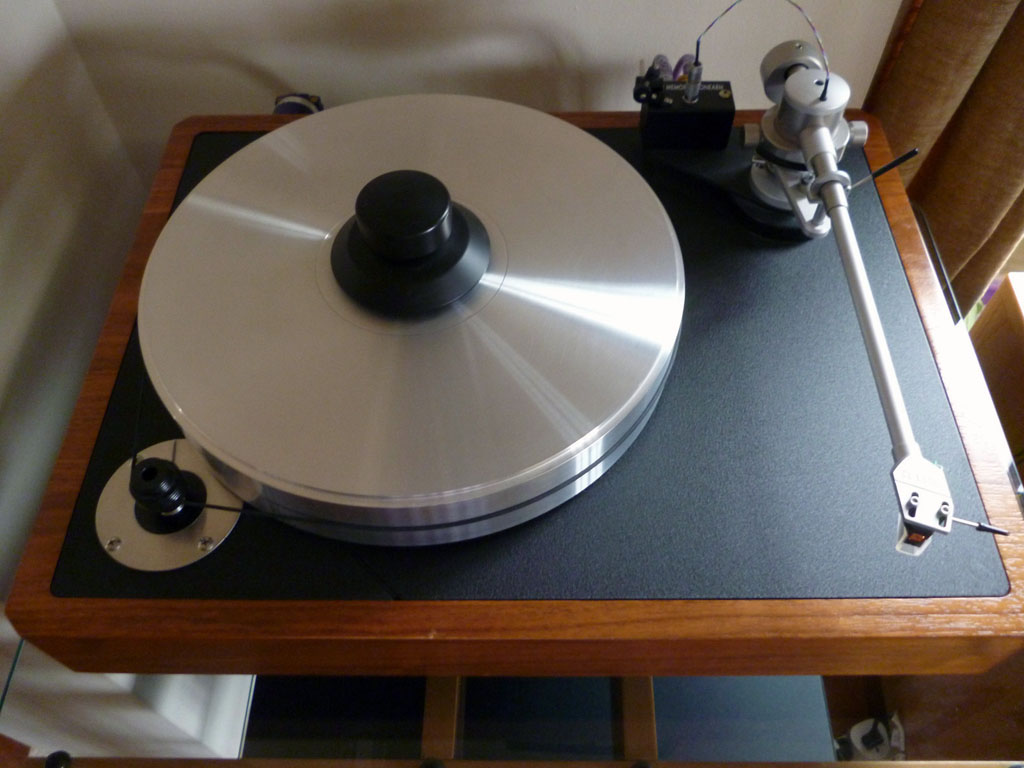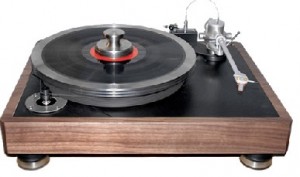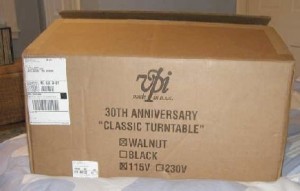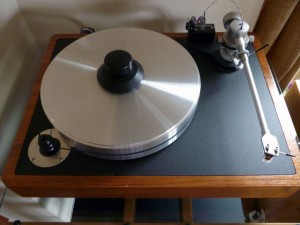Specifications
- Wow and flutter: Less than .02% Rumble: Greater than 80db down Speed accuracy: Within .1% Platter runout: +/- .001 inch
- Dimensions: 20.75″ W x 15.75″ D x 10″ H (Including to nearm wire loop)
- Weight: 48 pounds (net) Price: $2,500
- Manufacturer: VPI Industries, Inc., 77 Cliffwood Avenue, #3B, Cliffwood, NJ 07721
I like vinyl—a lot. Despite a decently sized collection of CDs and SACDs, I listen mostly to LPs, and even review a few of them for this publication. Needless to say, I enjoy turntables as well: I own nine or ten of them: Linn, Thorens, AR, Philips, B&O, Dual, Transcriptors. They’re like my kids, I love each of them in their own way. Realistically, though, I end up using only a handful regularly. My primary units are my tweaked Linn LP12 and my heavily modified AR XA; I’ve been doing 90% of my listening on these turntables over the past year or so.
Suspended turntables have always been my preference. This dates back to my freshman year in high school in the early seventies when I worked at my school’s FM radio station. The station used two AR XA turntables for vinyl playback. A bit inconvenient, but these gorgeous turntables defined the genre for me, and I’ve carried with me since the image of a “proper” turntable as being suspended.
More recently I’ve given a great deal of thought to non-suspended turntables. This is a different concept, to be sure but one that is appealing in its own right. The VPI ‘tables’, in particular, piqued my interest. There seems to be a certain “solidity” to these units, and a particular attention to engineering and machining. On a recent visit to Peter Ledermann at The SoundSmith, I was fortunate to listen to one of his Saving Grace LPs on his VPI HRX turntable, and I liked what I heard. Visually, I prefer a turntable with a beautiful wooden base, however, and there wasn’t a VPI that ticked that box, until now!
As soon as I saw a photo of the Classic, I knew that I would have to listen to it. More than anything, the look reminded me of vintage AR turntables: The simplicity, the thick aluminum platter, and the straightforward-looking tonearm all yelled “XA”. Over at VPI, the Weisfelds kindly agreed to provide a unit for review.
Unlike the Classic, my review will appear in parts: This first part will focus on the turntable itself and my experience setting it up. The second installment will provide commentary on how it sounds. And the final installment will focus on how the Classic compares to other turntables in my collection.
UPS delivered the box one day; I found it on the middle of the kitchen floor. No one had apparently attempted to move it. When I tried to pick up the box, I understood why: It was so heavy that I thought it had mistakenly been packed with a vintage monster receiver, or perhaps a particularly powerful McIntosh power amp. Boxed, this turntable must weigh over 60 pounds.
I staggered to my upstairs listening room and, with the help of my 10 year old son, another turntable fan, and we began to unpack. The top “layer” contained the tonearm, counterweight, belt, cartridge alignment jig, damping fluid, instruction manual, clamp and various tools. It also included a Shure stylus pressure gauge, a particularly nice touch. I use a digital unit myself, but the inclusion of this item shows great attention to detail.
Removing the top layer revealed the “payoff”: The walnut-based Classic sitting encased in plastic, platter apparently in place on the bearing (yikes!).
Hefting the turntable out of its box is a job in itself; I was pleased to have an extra set of hands available. Further unpacking revealed that the platter was, in fact, resting on some packing material with no pressure on the bearing.
Once unpacked, setup of the turntable itself was a snap: Place the platter on the bearing, position the belt, attach the (provided) power cord to the receptacle on the back of the Classic, attach the (not provided) interconnects (VPI is unusual in that its tonearm cables are terminated in female RCA connectors), then all that remained was to set up the tonearm. As one might expect, this took the lion’s share of setup time. (By the way, this turntable can be purchased with a factory-installed and set up Dynavector 20X Special or a VPI/Grado cartridge. The lazy man’s approach!)
As with all current VPIs, the Classic includes a unipivot tonearm, in this case the JMW Memorial 10.5 SE. (Unlike the “normal” 10.5, the SE foregoes “on the fly” VTA adjustment. Due to the nature of the unipivot, as compared to gimbaled tonearm, great care is required to ensure that the azimuth adjustment is just right.
I removed the Grado Reference Sonata cartridge from my LP12 and installed it on the tonearm’s headshell. VPI provides hardware for non-threaded cartridges, but recommends using the cartridge manufacturer’s screws for mounting threaded cartridges like the Grado wood bodies. Mounting the cartridge was easy. I then put the counterweight on the arm and placed the arm on the very, very sharp pivot point. The instruction manual actually warns against touching this point lest you injure yourself.
Actually adjusting the cartridge is a typically fiddly process, made meaningfully easier by VPI’s provision of a customized setup jig. For the VPI azimuth is set by rotating the counterweight to the left or right, as on my Transcriptors Hydraulic Reference. It takes a bit of skill, or lots of trial and error, to get this right without inadvertently changing the tracking force. I would have appreciated an azimuth adjustment separate from the counterweight, though it took me very little time to “get it right”.
At this stage I realized that I had a couple of issues…
- The counterweight supplied was too heavy for my Grado cartridge, and I couldn’t make the tracking force exceed 1.45 grams (I usually run the Sonata at 1.80). There are a couple of ways to deal with this issue (other than buying heavier cartridge, of course). One is to add weight to the headshell; VPI makes a three gram weight for this purpose. The second is to use lighter counterweight. My e-mail to VPI was swiftly returned by Harry Weisfeld, who noted that VPI supplies five different counterweights for this tonearm, and that a lighter weight would be on its way to me shortly.
- My high-output Grado hums almost as noticeably on the Classic as it does on my LP12. Not unexpected, but disappointing nonetheless. I’ll be looking at alternative cartridges when I review the sound of the turntable.
VPI supplies an anti-skating mechanism with the tonearm, but doesn’t recommend its use unless the listener is not happy with the anti-skate provided by the tonearm cable loop. When I review the sound of this turntable I’ll try it both ways.
So that is where we stand at the moment: Turntable unpacked and set up, but not yet optimized. While I wait for the counterweight, I thought I’d make a few comments about the Classic:
- The engineering: The turntable is beautifully machined and finished. Surfaces are pristine, and everything fits perfectly.
- Avoirdupois: I have never picked up a turntable this heavy, even sans packing material. It weighs nearly 50 pounds: Heavier than my power amp.
- The platter: It’s gigantic, heavy, and a work of art, contributing much to the weight of the unit overall. Though it seems to go slightly against the grain, VPI suggests using the platter with no mat to allow the clamp to work properly. When I clamped down LPs, a vacuum is created between the LP and the inner part of the platter (which is slightly depressed). You really get the sense of the vinyl “as one” with the platter. Harry Weisfeld let me know that he’s experimenting with a very thin (paper) mat that he’d send me to demo.
- Motor: Extremely torquey, quiet and with excellent speed stability (I checked it with my strobe). Speed is changed by manually moving the belt along one of many different grooves on the shaft.
Here’s what still needs to be done before I begin listening seriously:
- Install the turntable on a base: VPI suggests a slab of maple at least two inches thick. I found a John Boos maple cutting board on Amazon (2 ½ inches thick) which looks like it will fit the bill.
- Place the turntable on a stand with MDF shelves. The stand I used for setup purposes has Plexiglas shelves which are too flexible. Mass loading this ‘table is the way to go.
- Install the new counterweight and re-set the tracking force and azimuth. One of the advantages of having removable interconnects is the ability to see if different gear results in different sound. I’ve currently got a pair of Blue Jeans Cable interconnects (copper) mounted, but am expecting a pair of Ultimate Cable silver and copper interconnects to arrive soon.
Finally, VPI suggests using the damping fluid in the unipivot with Grado cartridges due to their slightly higher compliance than many MC cartridges. I’ll start listening without the fluid and will consider whether adding the fluid impacts the sound.
Review Equipment:
- Anthony Gallo Acoustics Reference 3.1 speakers
- McIntosh C712 preamplifier
- Yamaha MX-D1 stereo power amplifier and Anthony Gallo Acoustics Reference 3 subwoofer amplifier
- Sony XDR-F1HD tuner
- Linn Sondek LP-12 with Ittok LVIII Tonearm, Sumiko Blue Point Special EVO III Cartridge, Mose+Hercules II Outboard
- Power Supply, Cetech Carbon Fiber Subchassis and Armboard, Herbie’s Way Excellent II Turntable Mat
- Shanling SCD-T200 SACD player
- Apple iPod Classic, 160 gb
- Mapleshade speaker wire, Blue Jeans speaker cable and interconnects,
- Ultimate Cables, AudioQuest, ProSolutions and AR interconnects
 from affordableaudio, By Peter D’Amario
from affordableaudio, By Peter D’Amario











If I can pick your brain, trying to decide between purchasing an AR Classic 1 or modding my AR ES. In your experience between the two, how much difference was there?